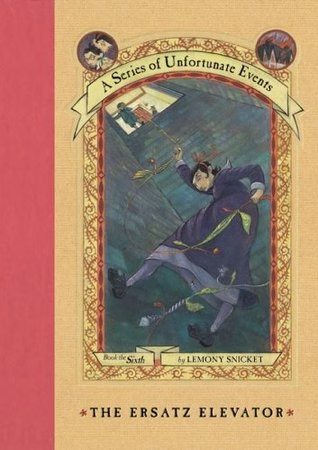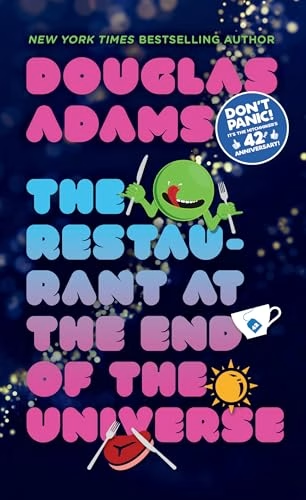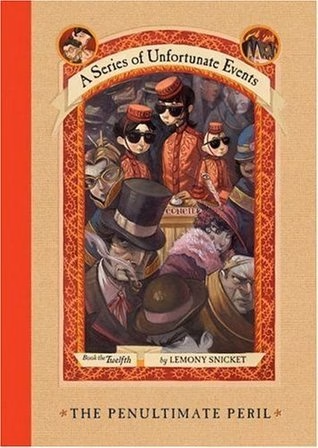Plot Summary
Down the Stricken Stream
The story begins immediately after the Baudelaires’ escape from the V.F.D. headquarters fire in the Mortmain Mountains. Violet, Klaus, and Sunny are adrift on a toboggan, carried down the rushing, ashen waters of the Stricken Stream. They have been separated from their friend, Quigley Quagmire, who was swept away by another tributary. The children feel passive and helpless, uncertain of their destination but knowing that Count Olaf and his troupe are in pursuit. As they travel, they witness the devastating aftermath of the Caligari Carnival fire, a fire they reluctantly helped start, which now blankets the hinterlands in ash. The stream widens and grows rougher until their toboggan collides with a mysterious object rising from the water: a metal periscope shaped like the V.F.D. insignia.
The Queequeg
After knocking on a hatch at the base of the periscope and providing the V.F.D. motto, “The world is quiet here,” as a password, the Baudelaires are welcomed aboard a submarine. They meet the vessel’s boisterous, eccentric captain, a man named Widdershins, whose personal philosophy is “He who hesitates is lost.” The submarine is called the Queequeg, and its crew consists of Captain Widdershins, his intelligent and kind stepdaughter Fiona, a mycologist, and Phil, the relentlessly optimistic former lumbermill worker the Baudelaires knew from Paltryville. The children are given uniforms and assigned tasks:
* Violet is to repair the submarine’s malfunctioning machinery, starting with the telegram device.
* Klaus is tasked with studying complex tidal charts to determine a specific location.
* Sunny, now a skilled cook, is put in charge of the galley with Phil.
A New Mission
Captain Widdershins and Fiona reveal that they were searching for the Baudelaires. They explain that V.F.D. headquarters was believed to be the location of a crucial item: a sugar bowl. They theorize that during the fire, the sugar bowl was thrown into the Stricken Stream and carried out to sea. The Queequeg’s mission is to find this sugar bowl before Count Olaf does. Klaus, studying the tidal charts, determines that the currents would have carried the object to a specific, mysterious location on the map marked only with an oval and the initials “G.G.” Fiona, consulting a book from her mycological library, identifies the place as the Gorgonian Grotto, a treacherous underwater cave. The book warns that the grotto is home to an extremely poisonous fungus, the Medusoid Mycelium. Despite the danger, the crew agrees they cannot hesitate and sets a course for the cave.
The Gorgonian Grotto
The Queequeg enters the grotto, but the cavern soon becomes too narrow for the submarine to proceed. The Baudelaires and Fiona don diving helmets and venture into the dark, cold water, letting the current carry them deeper into the cave. They are eventually deposited on a sandy beach inside a dry, hidden chamber, lit by three V.F.D.-marked floor lamps. The chamber is littered with objects washed up by the tide—remnants of V.F.D. activities from when the nearby Anwhistle Aquatics was operational. The children search for the sugar bowl but find only other V.F.D.-related items, including a book of poetry containing a new code (Verse Fluctuation Declaration) and a letter from Kit Snicket to Gregor Anwhistle discussing a schism within V.F.D. and the dangerous cultivation of a “volatile fungus.”
The Medusoid Mycelium
Suddenly, Fiona spots the Medusoid Mycelium sprouting silently from the sand. The fungus “waxes” and “wanes,” and it has just begun a waxing cycle, filling the beach with its deadly, gray, ink-spotted stalks. The children are trapped, unable to return to the water without being poisoned. While waiting for the fungus to wane, they uncover more secrets, including a newspaper clipping revealing that Fiona’s long-lost brother, Fernald, set the fire that destroyed Anwhistle Aquatics. After hours, the fungus finally wanes, disappearing back into the sand. The four volunteers suit up and swim back toward the Queequeg. On the journey, a single spore of the Medusoid Mycelium gets inside Sunny’s helmet, which she has been curled up inside.
Capture by the Carmelita
Upon returning to the Queequeg, they find Captain Widdershins and Phil have vanished. As they investigate, they discover a spore of the Medusoid Mycelium has begun to grow inside Sunny’s sealed helmet, poisoning her. Fiona insists they cannot open the helmet without contaminating the entire submarine. Sunny has less than an hour to live. Before they can find a cure, the submarine’s sonar detects an approaching vessel. An enormous, octopus-shaped submarine, the Carmelita, appears and swallows the Queequeg whole. Count Olaf, Esmé Squalor, and Carmelita Spats board the Queequeg, gloating over their capture.
A Shocking Reunion
Olaf dismisses Sunny’s plight and orders the children and Fiona to be locked in the brig. There, they are confronted by Olaf’s hook-handed associate, who is stunned to see Fiona. In a shocking twist, Fiona recognizes him as her long-lost brother, Fernald. Fernald, however, is initially hostile, demanding the location of the sugar bowl. The Baudelaires admit they don’t know where it is. Fiona pleads with her brother to help save Sunny, revealing the presence of the Medusoid Mycelium in her helmet. Fernald, who set the fire at Anwhistle Aquatics, is horrified, knowing the fungus’s power. He begins to waver, arguing that the lines between good and evil are blurred and that V.F.D. itself engaged in “Volatile Fungus Deportation.”
An Unlikely Escape and a Desperate Cure
Ultimately, Fernald offers them a Hobson’s choice: he will help them escape back to the Queequeg if they take him with them. Fiona agrees immediately. Fernald and Fiona create a diversion during Carmelita Spats’s dreadful tap-dancing recital, allowing Violet and Klaus to sneak away with Sunny. Back on the Queequeg, they race against time to find an antidote. Klaus deciphers a clue from a poem in Mushroom Minutiae, which suggests the cure is “root of horse.” He connects this to information from Kit Snicket’s letter about a V.F.D. factory on Lousy Lane that smelled of horseradish. Finding no horseradish, Sunny, in the last moments before succumbing to the poison, manages to whisper the name of its culinary equivalent: “Wasabi.” Violet realizes she still has a tin of wasabi Sunny found in the grotto. They feed it to Sunny, curing her just in time.
A Message and a Betrayal
With Sunny recovering, the Queequeg’s telegram device suddenly activates, delivering a message from Quigley Quagmire. Using the Verse Fluctuation Declaration code, he instructs them to meet him at Briny Beach the next day. Before they can make plans, Fernald and Fiona reappear. Fiona, wearing the uniform of Olaf’s troupe, announces she has chosen to join them to be reunited with her brother. She feels abandoned by her stepfather and believes this is her only way to have a family.
Escape from the Octopus
Count Olaf discovers the helmet containing the Medusoid Mycelium and gleefully plans to use it as a biological weapon. Just then, the sonar detects the approach of the “Great Unknown”—a massive, terrifying, question-mark-shaped object that dwarfs even Olaf’s submarine. In the ensuing panic, Fiona allows the Baudelaires to escape. She gives Klaus a parting kiss and tells him to think of a food he loves when he thinks of her. The Baudelaires fire up the Queequeg’s engines. Sunny resourcefully repairs the broken porthole with chewing gum as Violet and Klaus navigate the submarine out of the Carmelita. Once free, they glimpse the enormous, shadowy form of the Great Unknown before it disappears into the depths.
Arrival at Briny Beach
The Baudelaires pilot the Queequeg through the night and arrive at Briny Beach the next morning. The location is deeply poignant, as it is where their unfortunate events began. They are met not by Quigley, but by Mr. Poe, who tries to take them to the police station. Remembering the decoded message from Quigley—”violet,” “taxi,” “waiting”—Violet spots a taxi at the curb. The Baudelaires ignore Mr. Poe’s sputtering protests and run to the car. The driver is a poised, mysterious woman who introduces herself as Kit Snicket. She tells them to climb aboard, and as the book ends, they drive away, finally breaking the cycle of being passed from one ineffective guardian to another.
Characters
Violet Baudelaire
The eldest sibling and a brilliant inventor. Violet’s mechanical aptitude is critical, from her initial attempts to steer the toboggan to piloting the Queequeg out of Olaf’s submarine. She is the group’s pragmatic leader, often making difficult decisions under pressure. Her longing for connection is evident in her thoughts of Quigley Quagmire. In this book, she also takes on a more assertive role, directly confronting the moral complexities presented by Fiona and Fernald.
Klaus Baudelaire
The family’s researcher and middle child. Klaus’s intellectual curiosity and vast knowledge are central to the plot. He deciphers the tidal charts that lead them to the Gorgonian Grotto, uncovers the Verse Fluctuation Declaration code, and pieces together the history of Anwhistle Aquatics. He forms a strong, almost romantic, bond with Fiona, making her eventual betrayal deeply personal and painful for him.
Sunny Baudelaire
The youngest Baudelaire, who has developed beyond babyhood into a resourceful and intelligent young girl. Her vocabulary is expanding, and she has become a talented chef, capable of making meals from scavenged ingredients. Her sharp teeth remain a useful tool, but her greatest contribution is her culinary knowledge, which allows her to identify wasabi as the antidote that saves her own life.
Fiona Widdershins
A capable and intelligent mycologist who becomes a close ally to the Baudelaires. Fiona is defined by a deep internal conflict. Raised within V.F.D. and loyal to its ideals, she is ultimately unable to abandon her long-lost brother, Fernald, even though he is a villain. Her decision to join Olaf’s troupe is a pivotal moment, embodying the book’s theme that the bonds of family can override moral principles. Her parting kiss with Klaus signifies a tragic end to their burgeoning relationship.
Captain Widdershins
The enthusiastic, loud, and volatile captain of the Queequeg. He lives by the motto “He who hesitates is lost,” a philosophy that propels the story forward but also suggests a certain recklessness. He is a committed member of V.F.D., yet he mysteriously disappears from the submarine, leaving his stepdaughter and the Baudelaires to fend for themselves. His character represents the passionate but perhaps flawed nature of the “noble” side of the V.F.D. schism.
Fernald (The Hook-Handed Man)
Count Olaf’s long-serving henchman is revealed to be Fiona’s brother. Fernald is the book’s primary vehicle for exploring moral ambiguity. He argues that people are not “wicked or noble” but a complex mixture, like a “chef’s salad.” While he has committed villainous acts, including arson, he expresses regret and ultimately helps the Baudelaires escape. His character challenges the children’s previously straightforward worldview, forcing them to confront the idea that good people can do bad things and vice versa.
Count Olaf
The Baudelaires’ relentless nemesis. In this installment, Olaf is more equipped than ever, commanding a massive, technologically advanced octopus submarine. His villainy remains theatrical and self-aggrandizing, but his acquisition of the Medusoid Mycelium makes him a more terrifying threat than ever before. He is also shown to be fearful of a greater power—the mysterious shape on the sonar—revealing that even he is not at the top of the villainous food chain.
Core Themes
Moral Ambiguity
This is the central theme of The Grim Grotto. The story relentlessly dismantles the idea of a simple binary between good and evil. Fernald explicitly states that people are a mix of noble and wicked qualities. This is reinforced by the revelation that the “noble” V.F.D. was involved in weaponizing the Medusoid Mycelium, and by Fiona’s decision to join the “wrong” side for a personally justifiable reason—family loyalty. The Baudelaires are forced to question their own actions and the clear-cut morality they once believed in.
Family, Loyalty, and Betrayal
The definition of family and the obligations that come with it are heavily explored. The Baudelaires’ unbreakable sibling bond stands in contrast to Fiona’s story. She is torn between her found family with the Queequeg crew and her biological family in the form of her villainous brother. Her ultimate choice to prioritize blood ties over moral allegiance is presented as a tragic but understandable decision, highlighting the powerful and often complicated nature of family loyalty.
Secrets and Hidden Knowledge
The world of V.F.D. is built on secrets, and this book plunges the Baudelaires deeper into them than ever before. The narrative is driven by the pursuit of hidden information: the contents of the sugar bowl, the meaning of “G.G.,” the antidote to the mycelium, and the coded messages from Quigley. The Gorgonian Grotto acts as a literal submerged archive of V.F.D. history, holding truths that are both illuminating and dangerous. The story suggests that knowledge is powerful but that some secrets are too terrible to be known.
Passivity vs. Action
The book opens with the Baudelaires passively drifting on the current, a state they find deeply unsettling. Captain Widdershins’s philosophy, “He who hesitates is lost,” serves as a direct counterpoint, urging constant, decisive action. However, the story complicates this idea. While swift action is sometimes necessary for survival, the Baudelaires often succeed by hesitating, researching, and thinking through problems—proving that thoughtfulness is just as vital as bravery.
Plot Devices
The MacGuffin (The Sugar Bowl)
The sugar bowl is a classic MacGuffin, an object whose specific contents are irrelevant to the plot but whose importance to the characters drives their actions. Both the heroes and villains are desperate to acquire it, making it the focal point of their conflict. Its true significance remains one of the series’ greatest mysteries, fueling the sense of a much larger, secret-filled world.
The “Great Unknown”
The enormous, question-mark-shaped object detected on the sonar represents a threat so vast and terrifying that it frightens even Count Olaf. It functions as a symbol of the incomprehensible forces at play in the world, suggesting that the Baudelaires’ struggle with Olaf is just one small part of a much larger, more dangerous conflict. This “Great Unknown” expands the scope of the story’s mysteries beyond human villainy into something more primal and unknowable.
Coded Messages
The use of codes, particularly the “Verse Fluctuation Declaration” hidden within poetry, is a key narrative device. It reinforces the theme that knowledge and literacy are tools of power and survival. The ability to decode messages allows the Baudelaires to connect with allies like Quigley and navigate the secret world of V.F.D., while those outside this world of letters, like Mr. Poe, are left confused and ineffective.
Confined Spaces
The novel’s setting is a series of claustrophobic environments: the submarine, the underwater grotto, and the brig of Olaf’s vessel. These confined spaces heighten the sense of tension, entrapment, and vulnerability. The underwater setting isolates the characters from the rest of the world, forcing them to rely entirely on their own resources and creating a palpable atmosphere of suspense and danger.





